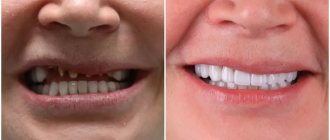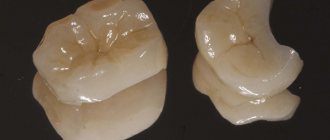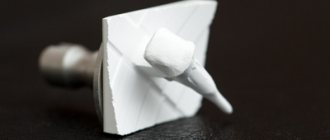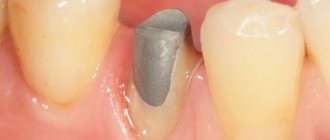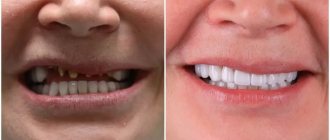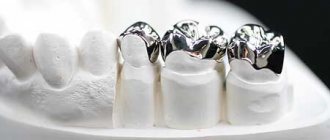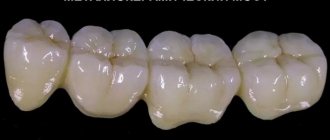Modern dental methods for restoring dental aesthetics will allow you to restore the beauty of your smile for many years quickly and painlessly. To eliminate extensive defects in the dentition, ceramic inlays are used on the tooth. In appearance, they are not much different from natural tooth enamel. With the help of the design, it is possible not only to restore the aesthetic characteristics of the units, but also to protect them from further destruction under the influence of caries and mechanical loads.
Ceramic inlays can last 10 years without shrinkage or deformation. They are created in special dental laboratories individually for each patient. The materials used to create structures are characterized by increased strength and resistance to external irritants. Installation of the tab takes place over several visits to the dentist (2-3 procedures). The cost of the dental procedure in question usually exceeds the price of a standard filling of decayed units.
What are they?
A ceramic inlay is a fragment that replaces the lost part of the teeth. They are designed to restore crowns that have been destroyed by more than 30%, and in cases where the use of conventional filling materials is not possible.
Products differ from each other in material of manufacture, production method and performance indicators. The inlay completely follows the shape and size of the teeth, protecting them from further destruction. The structure can be placed on both the external and internal sides of the teeth.
Dental crowns
If we are talking about crowns, this is a fairly voluminous restoration. Dental crowns are used to restore the anatomical shape of the tooth, chewing and speech functions, and create a beautiful aesthetic effect. A crown may be a necessary measure if the tooth’s nerve has been removed and a large amount of tissue is missing. It can also be installed on a living tooth to restore the original shape of the tooth and, as a result, the correct bite: the height of the tooth, the shape of the tubercles, the area of the chewing surface directly affect the bite and the health of the teeth in the future.
Types of dental crowns
Indications and contraindications
The main indications for restoring the aesthetics of elements using structures:
- increased abrasion of enamel;
- severe mechanical damage to the crown of the tooth;
- destruction of the crown by more than 30%;
- the need to use the unit as a support for the prosthesis;
- using ceramic inlays instead of fillings.
The products are an improved version of fillings that are made to order. Installation of structures is not possible in all cases.
Contraindications for the procedure are:
- the need to restore milk elements;
- destruction of the crown by more than 60-70% (in this case, doctors offer crowns to patients);
- lack of a healthy root system of the tooth;
- serious mechanical damage to the unit, in which nothing remains of it;
- destruction of incisors or canines (inlays, as a rule, are not used for the restoration of these elements);
- progression of carious processes in the oral cavity.
Photos before and after installing a ceramic inlay
Experts also do not recommend restoring wisdom teeth using ceramic structures. Eights do not play any role in the process of chewing food and are invisible to others, so there is no point in spending money on their expensive restoration.
In what cases is the installation of a stump tab indicated?
If a tooth is destroyed by 70% or more, its restoration with filling material using a pin becomes impractical - such a design cannot withstand loads. In this case, there is a threat of fracture of the root itself. This leads to tooth extraction, which means prosthetics become more complicated. Therefore, if there is practically nothing left except the root, the best option would be to install a stump tab. At the same time, the edge of the tooth must still protrude above the gum, on which it can be fixed, otherwise it will be impossible to install an artificial stump.
Important! You can use a stump tab only if there is a healthy root.
The inlay is also used if the tooth is being prepared as a support tooth for a bridge or splinting structure - this increases their reliability.
It is possible to use this technique for pathological tooth wear, as well as anomalies in the development of anterior teeth in adults that cannot be eliminated by orthodontic methods.
The difference between an inlay and a filling
Which is better: a filling or an inlay? The main distinguishing characteristics between the two types of products are discussed in the table below.
| Characteristic | Tab | Seal |
| Mode of production | Created indirectly in a dental laboratory using a three-dimensional model | Created directly in the patient's mouth |
| Production time | From several days to several weeks | One day |
| Number of visits to the doctor for installation | 2-3 visits, depending on the complexity of the clinical case | 1 visit for uncomplicated caries |
| Restoration zones | Chewable units | Any teeth |
| Quality of adhesion to enamel | Perfect | Shrinkage possible |
| Operating time | 7-10 years | 3-5 years |
Pros and cons of tabs
Ceramic inlays have a number of advantages compared to other methods of restoring teeth. The advantages of a ceramic tooth inlay include:
Veneers on teeth: pros and cons
- the ability to mask large cavities and destroyed fragments;
- no need to adjust the size of the product due to its exact fit (seals do not meet these criteria);
- no staining from food or changes in original external characteristics;
- minimal risk of developing allergic reactions due to the high biocompatibility of the materials of the inlay and the oral mucosa;
- stability and strength, which makes it possible to consume familiar food products, including hard ones (nuts, seeds, crackers);
- no discomfort during operation.
Inlays also have a number of disadvantages, among which patients highlight:
- long recovery period after the procedure;
- the need to wait for the production of products;
- high cost of restoration;
- the need for several visits to the clinic.
Which ones are better to choose?
Clinics offer many options for crowns. One of the differences between them is the material used. It is on this parameter that the quality, cost, indications for the use of a particular crown and, of course, aesthetics largely depend. Another very important nuance that also affects the quality parameters is the manufacturing technology of the product.
Types of crowns
- Metal crowns.
They are considered hopelessly outdated. They can be made from various alloys (cobalt-chromium, nickel-chromium). Among the disadvantages are the not very aesthetic appearance, the risk of an allergic reaction to the metal. - Crowns made of precious metals.
As a rule, these are solid prostheses made of gold-platinum alloy. They allow you to achieve the necessary strength and maintain biocompatibility. However, crowns are not made entirely from this alloy. It is used as a frame for metal-ceramic crowns and is covered with ceramics on top. - Metal-ceramic crowns.
The most common products that consist of a metal frame and ceramic cladding. First, the frame is cast, then a layer of ceramic is applied, which can be manufactured using computer modeling. - All-ceramic crowns.
Metal-free ceramic crowns. Due to its biological inertness, this material is considered one of the safest for soft tissues. Manufactured using firing technology (on a refractory model or platinum foil); ceramic pressing method (surface painting technique or layering technique); on a milling machine using CAD/CAM computer modeling. - Zirconium dioxide crowns.
They are manufactured using computer modeling using special milling equipment. There are two types of zirconium dioxide crowns: monolithic (entirely made of zirconium dioxide without veneering) and combined (porcelain mass is applied to a zirconium dioxide frame). The presence of a frame allows you to hide darkened teeth, as well as existing metal inlays and pins. This gives the prosthesis more aesthetics.
There are also temporary crowns that are placed while the permanent structure is being manufactured, but we cannot talk about them as a full-fledged orthopedic structure.
Each of these types of crowns has variations within its category (type of alloy, material features, production method). The overall quality indicator consists of many nuances that must be taken into account when choosing a product. Below is a table with the main parameters that determine the quality of the crown. Two plus signs or two minus signs indicate a characteristic feature of the crown in a particular indicator.
Quality table
| Product | Strength | Aesthetics | Durability |
| Metal crown | + | – – | +/– |
| Golden crown | + | – | + |
| Metal-ceramic crown | +/– | +/– | +/– |
| Ceramic crown | + (depending on the type of crown) | ++ | + |
| Zirconium dioxide crown | + | + | ++ |
All types of crowns are capable of restoring the functionality of a tooth, but the appropriateness of choosing one or another product largely depends on the specific clinical case.
Kinds
There are 3 main types of inlays, which differ in material of manufacture, service life and cost. The modern type of material from which products are made is metal ceramics. Their cost is not much different from ceramic structures, but in quality they are significantly inferior to them. Cermet inlays may fall out when exposed to too high or low temperatures. This is due to the ability of the metal to expand under the influence of temperature factors. For this reason, dentists do not advise patients to resort to modern methods of dental reconstruction.
Inlays can also be made from pressed ceramics. Porcelain is used to produce structures of the required shape and size under the influence of high temperatures. As a result of laboratory work, inlays are durable and resistant to external influences. In terms of strength, they are not inferior to zirconium samples. Ceramic structures are recommended for use in cases of significant destruction of dental elements.
Zirconium is another material used to make inlays. The resulting products are in no way inferior to porcelain in terms of technical characteristics. They are turned on modern machines using pre-prepared plaster models. All stages of work are controlled automatically by high-precision devices.
It is allowed to use stump products to restore a completely destroyed coronal part, provided that the tooth root is preserved. After the procedure, a crown or bridge is attached to the tab
Depending on their purpose, structures are divided into restorative and stump. The former allow you to restore the integrity of the tooth crown with a healthy root system.
Installation technique
Reconstruction of row elements using ceramic inlays occurs in stages:
- First, old fillings (if any) are removed. Teeth preparation occurs using a cooling system that prevents overheating of bone tissue. Grinding of the restored unit often occurs with the use of magnifying dental instruments (binocular glasses). Thanks to them, the doctor will be able to preserve a larger volume of healthy dentin tissue.
- After preparation, the resulting cavity is processed with a caries detector. The method allows you to identify the affected areas remaining after preparation.
- Precision grinding and smoothing of tooth edges with Arkansas stone. The steps of the procedure are necessary to ensure a good fit of the ceramic inlay.
- After this, an impression is taken from the problem unit, from which the dental technician will create an inlay. Checking the compliance of the parameters of the inlay with the resulting cavity is also carried out using binocular glasses.
At the last stage, the manufactured product is attached to the tooth. Various adhesives are used for this purpose. After installation of the structures, the patient will need to adhere to a number of rules in order to extend the life of the inlays.
Private clinics practice a new method of dental restoration using the Chairside technique, which allows you to restore the aesthetics of your smile in one visit to the dentist.
During the procedure, the dentist uses a device equipped with a three-dimensional camera. Powder is applied to the work area before taking the photo. This makes the image more accurate and clear. The 3D device transmits the resulting image to a large screen and uses it to calculate the parameters of the future tab. All data is transmitted to the grinding unit, which grinds the product. The procedure takes no more than 30 minutes.
Service life and care features
Dentists claim that the maximum service life of ceramic inlays is 5 years, but this time can be extended with proper care of the product. Many manufacturers offer a 10-15 year warranty on zirconia and pressed ceramic products.
In order to carry the tab as long as possible, you must:
- brush your teeth 2 times a day for at least 2-3 minutes;
- rinse the mouth with special solutions or water after eating;
- refuse actions associated with strong pressure on the jaws and closing them together;
- Visit the dentist at least once every 6 months.
A crown with an inlay fell out: what to do?
The loss of an inlay with a crown is a consequence of poor tooth installation technology. After inserting the core tab, you need to wait at least a day before grinding it using a dental grinder. If you start almost immediately, without delaying the last, third stage - adjustment - you can displace or even break the adhesive or cement joint.
If the inlay falls out along with the crown, immediately contact your dentist so that he can carry out the fixation procedure again.
Price
Let's consider the average cost of ceramic inlays in Moscow, depending on the material they are made of. The table also shows the advantages and disadvantages of each type of product.
| Material | Price | pros | Minuses |
| Metal based ceramics | 10-15 thousand rubles. | Increased strength due to the inclusion of a metal frame | High risk of falling out of the mouth |
| Pressed ceramics | 15-20 thousand rubles. | Relative strength, high aesthetic characteristics, long service life | Risk of chipping |
| Zirconium dioxide | 25-30 thousand rubles. | Natural appearance, service life up to 20 years | High price |
In the course of life, people often encounter the appearance of chips and cracks in their teeth. Ceramic inlays, which have undeniable advantages over the traditional filling procedure, will allow you to restore the aesthetics of the element. After the treatment, the patient will not need to comply with special conditions for oral care.
Advantages and disadvantages
Advantages of the tab:
- no predisposition to cracks,
- insensitivity to food colorings,
- copying the tooth shape,
- exact match to the bite,
- maintaining the original appearance regardless of the years that have passed since the installation of the tab,
- giving teeth a natural, finished aesthetic appearance,
- extending the life of natural teeth.
Flaws:
- installation takes more than one hour;
- Prices for inlays are many times more expensive than for fillings.
However, more or less wealthy people who often appear in public are unlikely to refuse inlays if their teeth have become significantly unusable.
